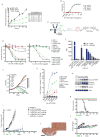Identification of GPC2 as an Oncoprotein and Candidate Immunotherapeutic Target in High-Risk Neuroblastoma
- PMID: 28898695
- PMCID: PMC5600520
- DOI: 10.1016/j.ccell.2017.08.003
Identification of GPC2 as an Oncoprotein and Candidate Immunotherapeutic Target in High-Risk Neuroblastoma
Abstract
We developed an RNA-sequencing-based pipeline to discover differentially expressed cell-surface molecules in neuroblastoma that meet criteria for optimal immunotherapeutic target safety and efficacy. Here, we show that GPC2 is a strong candidate immunotherapeutic target in this childhood cancer. We demonstrate high GPC2 expression in neuroblastoma due to MYCN transcriptional activation and/or somatic gain of the GPC2 locus. We confirm GPC2 to be highly expressed on most neuroblastomas, but not detectable at appreciable levels in normal childhood tissues. In addition, we demonstrate that GPC2 is required for neuroblastoma proliferation. Finally, we develop a GPC2-directed antibody-drug conjugate that is potently cytotoxic to GPC2-expressing neuroblastoma cells. Collectively, these findings validate GPC2 as a non-mutated neuroblastoma oncoprotein and candidate immunotherapeutic target.
Keywords: MYCN; antibody-drug conjugate; glypican; immunotherapy; medulloblastoma; neuroblastoma.
Copyright © 2017 Elsevier Inc. All rights reserved.
Figures







Comment in
-
Scratching the Surface of Immunotherapeutic Targets in Neuroblastoma.Cancer Cell. 2017 Sep 11;32(3):271-273. doi: 10.1016/j.ccell.2017.08.011. Cancer Cell. 2017. PMID: 28898689
References
-
- Casucci M, Nicolis di Robilant B, Falcone L, Camisa B, Norelli M, Genovese P, Gentner B, Gullotta F, Ponzoni M, Bernardi M, et al. CD44v6-targeted T cells mediate potent antitumor effects against acute myeloid leukemia and multiple myeloma. Blood. 2013;122:3461–3472. - PubMed
Publication types
MeSH terms
Substances
Grants and funding
LinkOut - more resources
Full Text Sources
Other Literature Sources
Medical
Molecular Biology Databases
Research Materials

